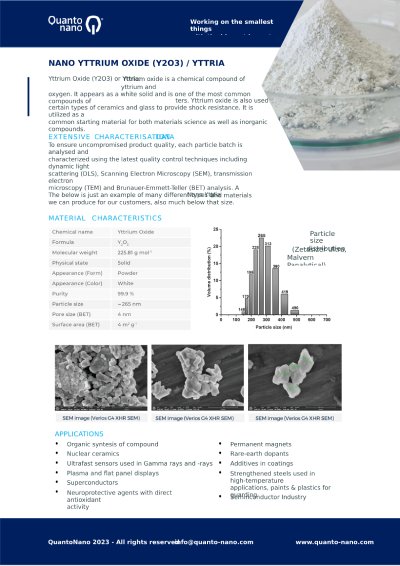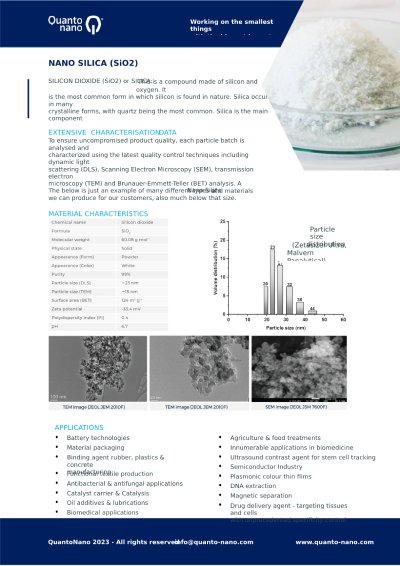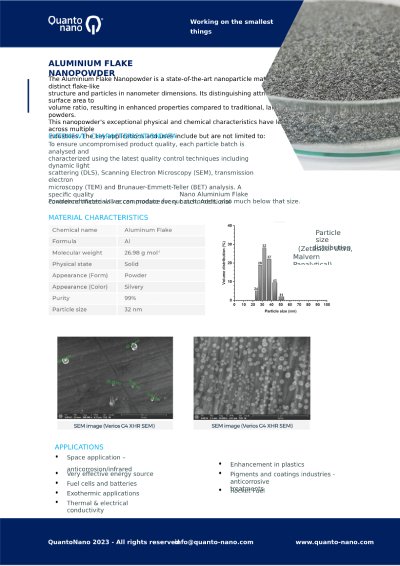Quanto Nano
Ultracapacitors
Quanto Nano
Product Categories
Quanto Nano
Activated Carbon (AC) Nano:
Quanto Nano has 3 different types of Activated Carbon (AC) and 9 types of Super Activated Carbon (AC) depending on the specific application
Carbon Nanotubes (CNTs)
Their unique structure provides excellent conductivity and mechanical strength. Used in high-power applications where rapid charging and discharging are necessary.
Hybrid Materials (e.g., AC combined with metal oxides or conductive polymers)
These combinations can enhance power density while maintaining reasonable energy density. Suitable for applications requiring both high power output and a moderate amount of energy storage. Combining materials like graphene with metal oxides can optimize both energy and power density, making them versatile for various applications.
Quanto Nano
Developing the Future of Energy Storage with Advanced Supercapacitors & Ultracapacitors
At Quanto Nano, we are dedicated to reshaping the landscape of energy storage through our state-of-the-art ultracapacitors and supercapacitors. Our mission is to provide groundbreaking energy solutions that are not only efficient and reliable but also sustainable and environmentally conscious.
Send Inquiry
Quanto Nano
KEY CONSIDERATIONS IN PERFORMANCE
Energy Density
How much energy can be stored. Higher in nano materials with high surface area and porosity.
Power Density
How quickly energy can be delivered. Higher in nano materials with good electrical conductivity.
Cycle Life
Durability over repeated charge-discharge cycles. Influenced by the mechanical stability of the material.
Cost and Scalability
Important for commercial applications. Materials like AC are relatively inexpensive and widely available compared to graphene.
Quanto Nano
SILICON DIOXIDE (SIO2) IN ENERGY STORAGE
- Insulating Nature of SiO2: It's essential to recognize that SiO2 inherently is an insulator rather than a conductor. In supercapacitors and ultracapacitors, where electrical conductivity is a critical factor, SiO2 doesn't directly contribute to electrical conduction. Instead, its utility lies in a different capacity.
- SiO2 in Composite Configurations: SiO2's significant contribution to energy storage technologies is through its incorporation in composite materials. When merged with conductive materials, SiO2 can considerably elevate the capacitor's overall functionality.
- Thermal Management: One of the paramount benefits of SiO2 is its exceptional thermal stability, playing a crucial role in handling heat during the charging and discharging cycles of supercapacitors and ultracapacitors.
- Capacitance Enhancement: SiO2, especially in nano-forms, can significantly augment the surface area available for charge storage, a critical factor for achieving elevated capacitance levels.
- Performance and Durability: SiO2's integration aids in effective thermal management, leading to improved performance, extended lifespans, and greater robustness of these storage devices.
- Customized Composite Coatings: The adaptability of SiO2 composites enables tailored supercapacitor and ultracapacitor designs for specific applications, optimizing performance based on the conductive elements used alongside SiO2.
- Ongoing Research: Continuous research in energy storage technology focuses on developing new SiO2-inclusive composites, aiming to strike an optimal balance between conductivity, heat management, and longevity.
- Real-World Applications: In practical scenarios, such as electric vehicles and renewable energy systems, SiO2 composites are increasingly being explored for their capability to offer rapid energy discharge and recharge while maintaining stability and efficiency during extended usage.
Conclusion

Quanto Nano
IRON OXIDES (FE2O3 AND FE3O4) IN ULTRACAPACITORS AND SUPERCAPACITORS
BENEFITS OF IRON OXIDES IN ENERGY STORAGE
High Energy Density
The pseudocapacitive nature of iron oxides, especially through Faradaic reactions, allows for higher energy storage compared to traditional capacitive materials.
Abundance and Cost-Effectiveness
Iron oxides are abundant and relatively inexpensive, making them an economically viable option for large-scale production.
Environmental Friendliness
Being naturally occurring materials, iron oxides are environmentally benign and non-toxic, contributing to the sustainable aspect of supercapacitors.
Good Cycle Stability
Fe2O3 and Fe3O4 demonstrate good cycling stability, which is crucial for the longevity and reliability of energy storage devices.
Versatility in Electrode Fabrication
Iron oxides can be easily integrated into various electrode structures, enhancing the flexibility of supercapacitor design.
APPLICATIONS OF IRON OXIDES IN ULTRACAPACITORS AND SUPERCAPACITORS
Electric Vehicles (EVs)
In EVs, iron oxide-based supercapacitors can assist in energy management, offering quick charge and discharge capabilities for acceleration and regenerative braking.
Renewable Energy Storage
They are ideal for storing energy in renewable systems like solar or wind farms, providing a buffer for the intermittent nature of these energy sources.
Power Grid Balancing
In power grids, these supercapacitors can aid in frequency regulation and load leveling, contributing to a more stable and efficient energy distribution.
Consumer Electronics
For portable devices, iron oxide supercapacitors can offer fast charging solutions and enhanced battery life.
Industrial Applications
These supercapacitors can be used in industrial settings for energy management, emergency power supply, and process control systems.
OTHER PROMISING MATERIALS IN ULTRACAPACITORS AND SUPERCAPACITORS
Graphene
Known for its exceptional electrical conductivity and surface area, graphene can significantly enhance the energy and power density of supercapacitors.
Conductive Polymers
Materials like polyaniline and polypyrrole offer pseudocapacitance and are used to increase the energy density of supercapacitors.
Transition Metal Oxides
Materials like MnO2, NiO, and Co3O4 are explored for their high specific capacitance and favorable electrochemical properties.
Hybrid Materials
Combining carbon-based materials with metal oxides or conductive polymers can synergize the benefits of each, leading to improved performance.
Carbon Nanotubes (CNTs)
CNTs are known for their high electrical conductivity and mechanical strength, enhancing the structural stability and performance of supercapacitors
Conclusion

Quanto Nano
HYBRID MATERIALS IN ENERGY STORAGE
The Role of Metal Oxides in Capacitator Applications
Manganese Oxide (MnO2)
Key Attributes: MnO2 stands out for its abundance, low cost, and eco-friendly nature. In combination with AC, it improves energy density while maintaining high power density.
Ruthenium Oxide (RuO2)
Advantages and Limitations: Known for its exceptional electrical conductivity and capacitance, RuO2 is used in high-performance supercapacitors. However, its cost is a consideration in large-scale applications.
Iron Oxide (Fe2O3 and Fe3O4)
Utilization: These oxides are explored for their abundance and cost-effectiveness, enhancing charge storage capacity and contributing to higher capacitance.
Nickel Oxide (NiO)
Performance Enhancement: NiO, with its high theoretical capacitance and stability, boosts energy density in supercapacitors.
Cobalt Oxide (Co3O4)
Contribution to Supercapacitors: Co3O4 is chosen for its excellent pseudocapacitive properties, improving energy storage and device durability.
How Hybrid Materials Enhance Supercapacitor Performance
Double-Layer Capacitance
AC provides a high surface area for ion adsorption, crucial for this type of capacitance.
Faradaic Reactions
Metal oxides add capacitance through redox reactions, increasing overall energy storage.
Synergy
The combination of AC and metal oxides leads to superior performance, blending double-layer capacitance and pseudocapacitance.
Diverse Applications of Quanto Nano’s Supercapacitors
Balanced Energy and Power Needs
Ideal for electric vehicles, portable electronics, and energy harvesting systems.
Tailored Solutions
Metal oxide choice varies based on application-specific requirements, cost, and environmental impact.
Transition Metal Oxides
Materials like MnO2, NiO, and Co3O4 are explored for their high specific capacitance and favorable electrochemical properties.
Hybrid Materials
Combining carbon-based materials with metal oxides or conductive polymers can synergize the benefits of each, leading to improved performance.
Carbon Nanotubes (CNTs)
CNTs are known for their high electrical conductivity and mechanical strength, enhancing the structural stability and performance of supercapacitors
CONCLUSION AND FUTURE OUTLOOK












